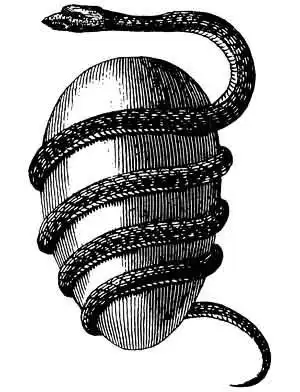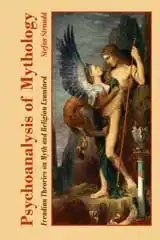Charles H. Long
His theories about mythology and religion examined by Stefan Stenudd
He remained there as a teacher and subsequently a professor. He was also one of the founding editors of the journal History of Religions, based at that university. In 1973 he was elected president of the American Academy of Religion, and in 1987 president of the Society for the Study of Black Religion.[1] He was neither a psychologist nor expressly a Jungian, but referred frequently to Jung’s ideas in his writing, which dealt substantially with mythology and its symbolism. In 1963 he published one of the first anthologies of creation myths around the world,Alpha: The Myths of Creation, in which he applied some Jungian principles to the material. On the other hand, in his 1986 book Significations: Signs, Symbols, and Images in the Interpretation of Religion, Jung is not mentioned at all, but Freud is. That may be due to the theme of the former book being myth, while the latter is about religion. Still, Jung certainly wrote about both subjects, and much more so than Freud. Long’s most renowned contribution to mythology is his writing on creation myths, as in his book Alpha: The Myths of Creation mentioned above. He also wrote the article on creation myths in Encyclopædia Britannica, which remains on its present online version[2] and a corresponding text on cosmogony in Mircea Eliade’s The Encyclopedia of Religion.[3]
Symbolic Creation MythsWhen a mythology contains a creation myth, which is a vast majority of them, that myth is of central importance to the whole mythology and the beliefs of the society adhering to it. Yet, when Charles H. Long’s anthology of creation myths from around the world, Alpha: The Myths of Creation, was published in 1963, it was — as far as I have found — only the second one in the English language. A few years earlier, in 1956, the American folklorist Maria Leach published The Beginning: Creation Myths Around the World, where she retold 62 myths in her own words. Since then, anthologies of creation myths have multiplied and swelled considerably.Long declares in the beginning of his book’s introduction that his approach to myth is that of a historian of religion,[4] but at the end of the same chapter he narrows his scope considerably:
Long regards creation myths as of fundamental importance, since they function as models for all kinds of beginnings: “The cosmogonic myth is the myth par excellence precisely because the beginnings of all things within the culture are modeled on the pattern of this myth.”[6] His interpretation of those myths is that they are expressions of symbolism:
He continues with describing it as a type of thinking representing “man’s initial confrontation with the power in life,” and the beings in the myth, such as gods, animals, and plants, are “forms of power grasped existentially.” What he seems to indicate in this roundabout way is the mystified manner in which primeval man regarded the powers of nature. But that is no mystery. A rational mind would be just as mystified before science gradually could explain things. Creation myths are full of examples of rational speculations, which seem irrational only when the very limited understanding behind those speculations is ignored. People did what they could with what little they knew. When Long suggests that their thinking was symbolic, he is adding complications instead of subtracting them. Symbols are abstractions made by minds aware of what it is they replace with the symbol. Therefore, it cannot be done before some kind of understanding of what is to be symbolized. The approach of explaining elements of myths as symbolic is used by many mythologists interpreting old myths, but there is no indication that it was done when the myths were formed and upheld. The symbols and their meanings are later inventions by writers on the subject, who have searched for general conditions of the human mind behind the formation of myth as well as religion. It is obvious when Long states: “The cosmogonic myths express the power, spontaneity, absoluteness, plenitude, and mystery of reality in symbolic forms.”[10] Concepts like power and absoluteness are symbolic to begin with, since they are not measurable or palpable. Mystery of reality combines two concepts, both of which resist a non-symbolic definition. What they indicate is the reason why our distant ancestors expressed themselves so differently from us about the world they lived in — reality was a mystery to them. They were not replacing their minimal knowledge of it with symbols, but their confusion made their descriptions confusing. They filled the wide gaps of their understanding with imagination. They saw powers at work in nature, but not their causes. So, they assumed them to be the doings of invisible beings, which were obviously so powerful that they should be treated with the greatest respect. These entities were not symbols of something else, but the most plausible explanations to what was observed. That plausibility is the main reason why this belief remained for so long. It made sense. A world completely void of invisible powers was unthinkable, since the manifestations of them were evident and plentiful. They were right, of course. There are invisible powers at work in the world. Contrary to our ancestors, though, we are aware of how they operate and no longer need the existence of invisible masters controlling them. With Long’s symbolic understanding of the myths, the depth psychology of Freud and Jung is near at hand, and he repeatedly refers to both. This is where he sees the source to symbolic thinking:
As for Freud’s Oedipus complex, he mentions that it has been criticized for being too dogmatic and hardly a total theory of man and religious symbolism, but he also insists that the problem of sexual tension is universal, as can be seen in the rites and beliefs of many diverse cultures. As for Jung’s archetypes, he seems to be both reserved and supportive:
Types of CreationAt the end of the introduction, Long explains how he will treat the creation myths he goes through in the following chapters:
There is no ambiguity to the egg, though, which is also found in many creation myths. What is dubious is that Long combines them into one category. He may have changed his mind later, since the egg is a separate category and the chaos type is absent in his article on cosmogony in Encyclopædia Britannica from 1976.[16]
The creation from nothing is a doctrine of the Christian church, though Genesis has a primordial sea to begin with, as well as an eternal deity. But Long adds to this category “a single Supreme Being,”[17] a sole deity responsible for all. This is a strange addition, which he deserted in the Encyclopædia Britannica article in 1976, where the supreme being is a category of its own and that of creation out of nothing is omitted. There is only one of Long’s examples that qualifies as a creation from nothing, an Egyptian myth about the first deity Khepri, since also he had a beginning: “I am he who came into being as Khepri. When I had come into being, being (itself) came into being, and all beings came into being after I came into being.”[18]
Long finds in this type of myth several important symbols, first of all water, which he interprets as a symbol of the chaotic stage before creation, but also a sign of destruction and renewal, as in the many flood myths. For the descent, Long applies a perspective which is distinctly Jungian:
It would not work as a symbol of the underworld, since that is always — as far as I am aware — underground, not in the sea. It makes more sense as an image of a return to the womb, but not in a creation story where it happens once and for all. The comparison with baptism and the idea of cleansing in water are not far-fetched, since water has always been used for washing, but not as a means to recreate. Water does not dissolve those dipped in it, and certainly not a creator deity plunging into it. It does nothing more radical than refresh, which is fine in itself. Long gets carried away by his symbolic thinking, which is a weakness he shares with both Freudians and Jungians. His method of extracting symbols from the creation myths leads him to imagine them where they are not or construct them by combining unrelated items. To primeval man as well as to us, water is simply that very familiar liquid surrounding land, which is also the role it plays in creation myths. There are similar problems with Long’s other types of creation myths. As he admits, there are often mixes of them in single myths, and in others the type of creation is not the initial or significant one. It is not easy to fit the creation myths of the world into those or any other fixed shapes. There will always be deviation and exceptions, which makes such a project rather futile and even misleading. The uncertainty of it is evident already in the variations of Long’s categories in different texts of his. That should have told him he might have been barking up the wrong tree, but still he persisted with it. Here are the types according to Alpha from 1963, Encyclopædia Britannica from 1976, and The Encyclopedia of Religion from 1987:
The three first types in the table are consistent in Long’s three texts on the subject, but after that there are variations. The combination of chaos and cosmic egg is unique to the 1963 text, but both 1976 and 1987 include the cosmic egg as a separate type. Chaos is absent in 1976, but present as a type of its own in 1987. Creation from nothing is missing in 1976, which instead has a supreme being as a type. The supreme being is mentioned in the 1963 and 1987 texts about creation from nothing, whereas the creation from nothing is implied but not explicitly mentioned in the 1976 text about the supreme being. The existence of a supreme sole creator in a myth, and that is not uncommon, does not necessarily mean the creation was out of nothing. As stated earlier, the idea of a primordial nothing is extremely rare in mythology. Mircea Eliade, Long’s professor and major influence, made his own list of creation myth types in 1967, with four basic categories whereof the third is divided into three subgroups:
It is definitely both possible and productive to categorize creation myths as well as mythologies in general, but to avoid misrepresentation it should be done with basic and precise types that are not designed to imply a certain interpretation of them. It should be as neutral as, say, describing the color of garments. Some are blue, some red, and so on. Many of them have mixed colors. When hastening to extract symbols with complex meanings to different creation myths, their content is obscured and distorted. What is reasonably safe to deduce is, for example, that some creation myths have one creator and the others have several, each doing their part of it. In some there is no deity present before creation, and in the others there is at least one. Some begin with nothing, and they are very rare, while the others start with something already there, the initial something being a gap or a sea or something else. In some myths humans are introduced early in the story and in others they are created much later. And so on. The categories should be based on the concrete and not the abstract, what is actually stated in the myths and not what might be implied. Consequently, it is neither trustworthy nor fruitful to divide creation myths into categories, but to look at their components. A creation myth can have components of different types, and many do. That is only a problem when they are sorted by types. So, it should be abandoned.
[1] Charles H. Long obituary at the University of Chicago/Divinity School website, 2020 (divinity.uchicago.edu/news/charles-h-long-1926-2020). [2] Charles H. Long, "Creation, Myths and Doctrines of,"The New Encyclopædia Britannica, Macropædia, vol. 5, Chicago 1976, pp. 239-243 (online at: britannica.com/topic/creation-myth). [3] Charles H. Long, "Cosmogony," The Encyclopedia of Religion, ed. Mircea Eliade et al., volume 4, New York 1987, pp. 94-100. [4] Charles H. Long, Alpha: The Myths of Creation, New York 1963, p. 1. [5] Ibid., p. 33. [6] Ibid., p. 30. [7] Ibid., p. 18. [8] Ibid., pp. 15f. [9] Ibid., p. 12. [10] Ibid., p. 20. [11] Ibid., p. 15. [12] Ibid., p. 5. [13] Ibid., pp. 22f. [14] Ibid., p. 33. [15] Ibid., p. 109. [16] Charles H. Long, "Creation, Myths and Doctrines of,"The New Encyclopædia Britannica, Macropædia, vol. 5, Chicago 1976, p. 241. [17] Long 1963, p. 148. [18] Ibid., p. 183. [19] Ibid., p. 188. [20] Ibid., p. 190. [21] Mircea Eliade, From Primitives to Zen: A Thematic Sourcebook of the History of Religions , New York 1967, p. 83.
Jungians on Myth and Religion
This text is an excerpt from my book Archetypes of Mythology: Jungian Theories on Myth and Religion Examined from 2022. The excerpt was published on this website in January, 2023.

MYTH
IntroductionCreation Myths: Emergence and MeaningsPsychoanalysis of Myth: Freud and JungJungian Theories on Myth and ReligionArchetypes of Mythology - the bookPsychoanalysis of Mythology - the bookIdeas and LearningCosmos of the AncientsLife Energy EncyclopediaOn my Creation Myths website:
Creation Myths Around the WorldThe Logics of MythTheories through History about Myth and FableGenesis 1: The First Creation of the BibleEnuma Elish, Babylonian CreationThe Paradox of Creation: Rig Veda 10:129Xingu CreationArchetypes in MythAbout CookiesMy Other WebsitesCREATION MYTHSMyths in general and myths of creation in particular.
TAOISMThe wisdom of Taoism and the Tao Te Ching, its ancient source.
LIFE ENERGYAn encyclopedia of life energy concepts around the world.
QI ENERGY EXERCISESQi (also spelled chi or ki) explained, with exercises to increase it.
I CHINGThe ancient Chinese system of divination and free online reading.
TAROTTarot card meanings in divination and a free online spread.
ASTROLOGYThe complete horoscope chart and how to read it.
MY AMAZON PAGE
MY YOUTUBE AIKIDO
MY YOUTUBE ART
MY FACEBOOK
MY INSTAGRAM
MY TWITTER
STENUDD PÅ SVENSKA
|
 Archetypes of Mythology
Archetypes of Mythology Psychoanalysis of Mythology
Psychoanalysis of Mythology